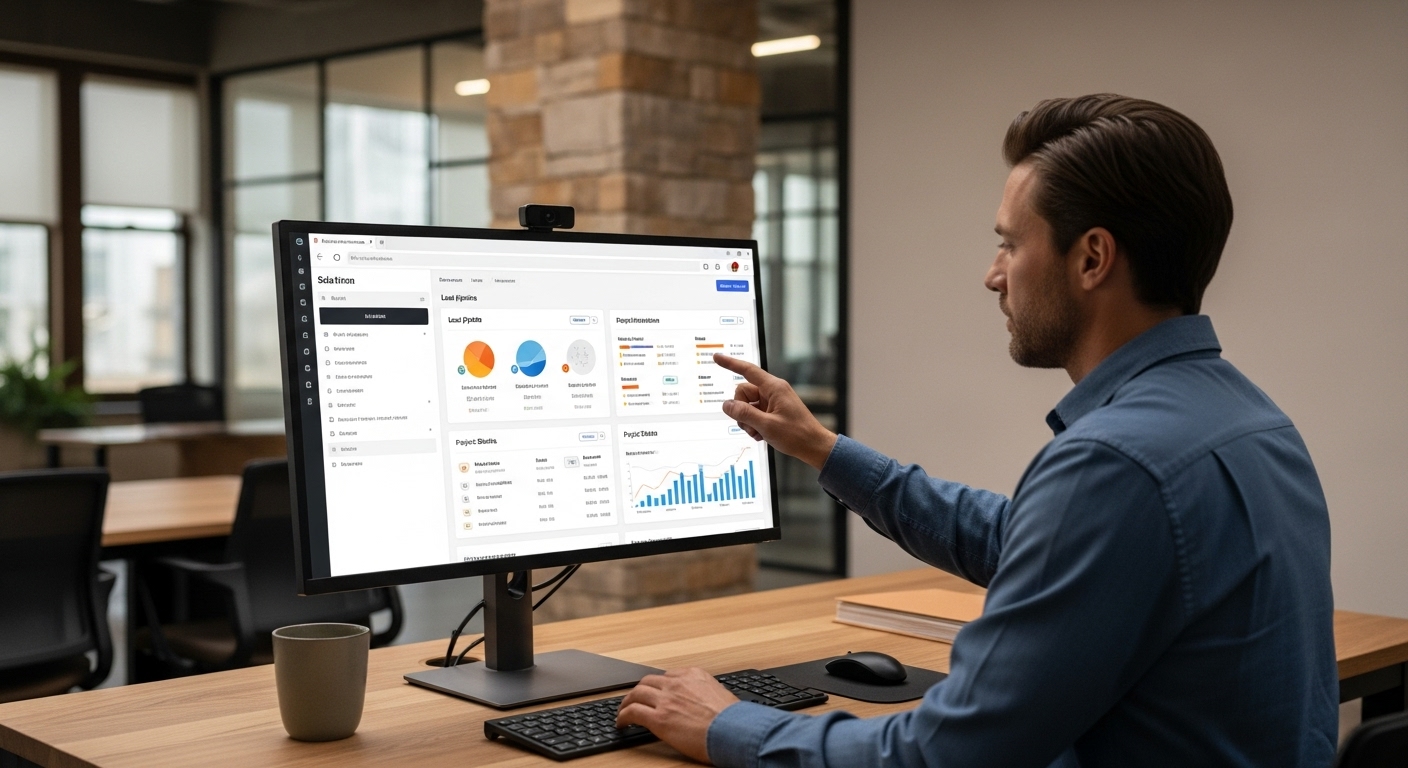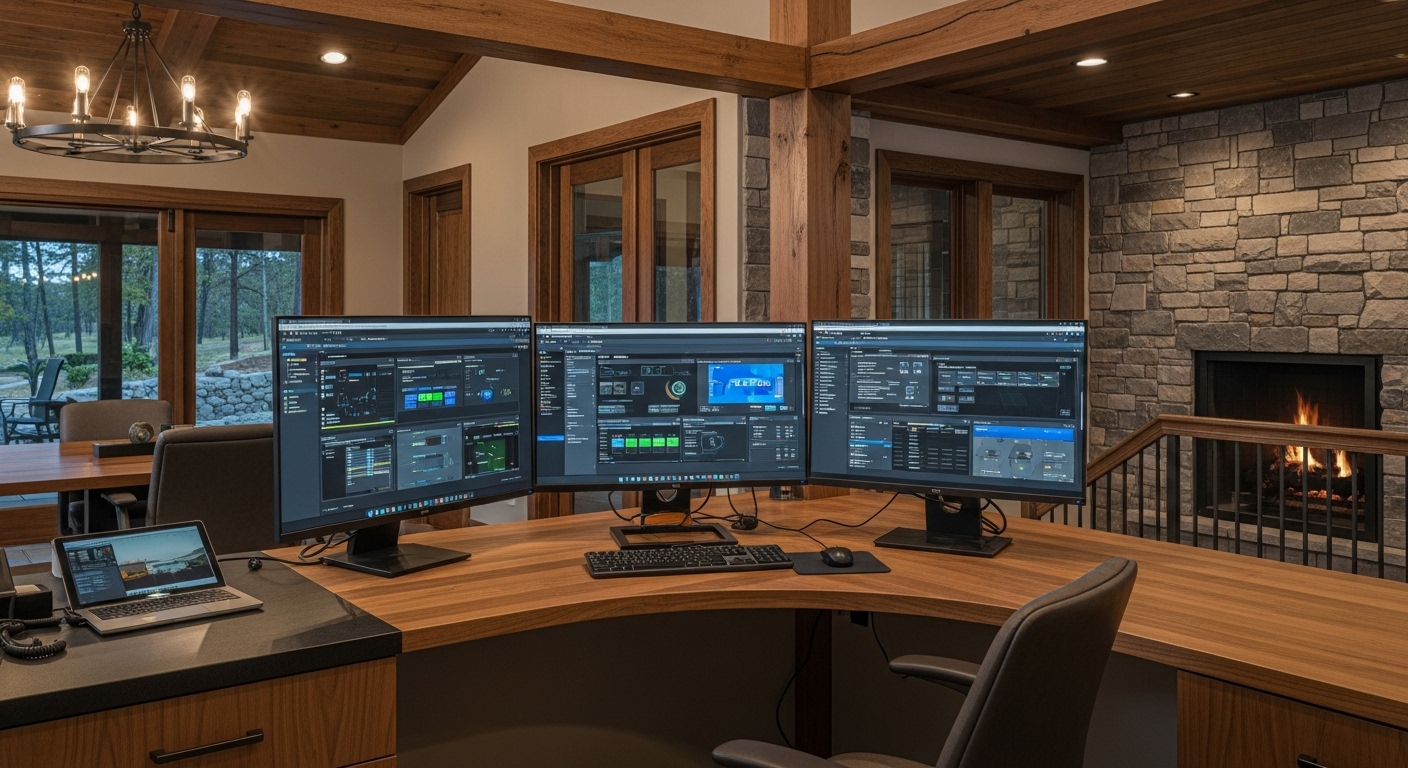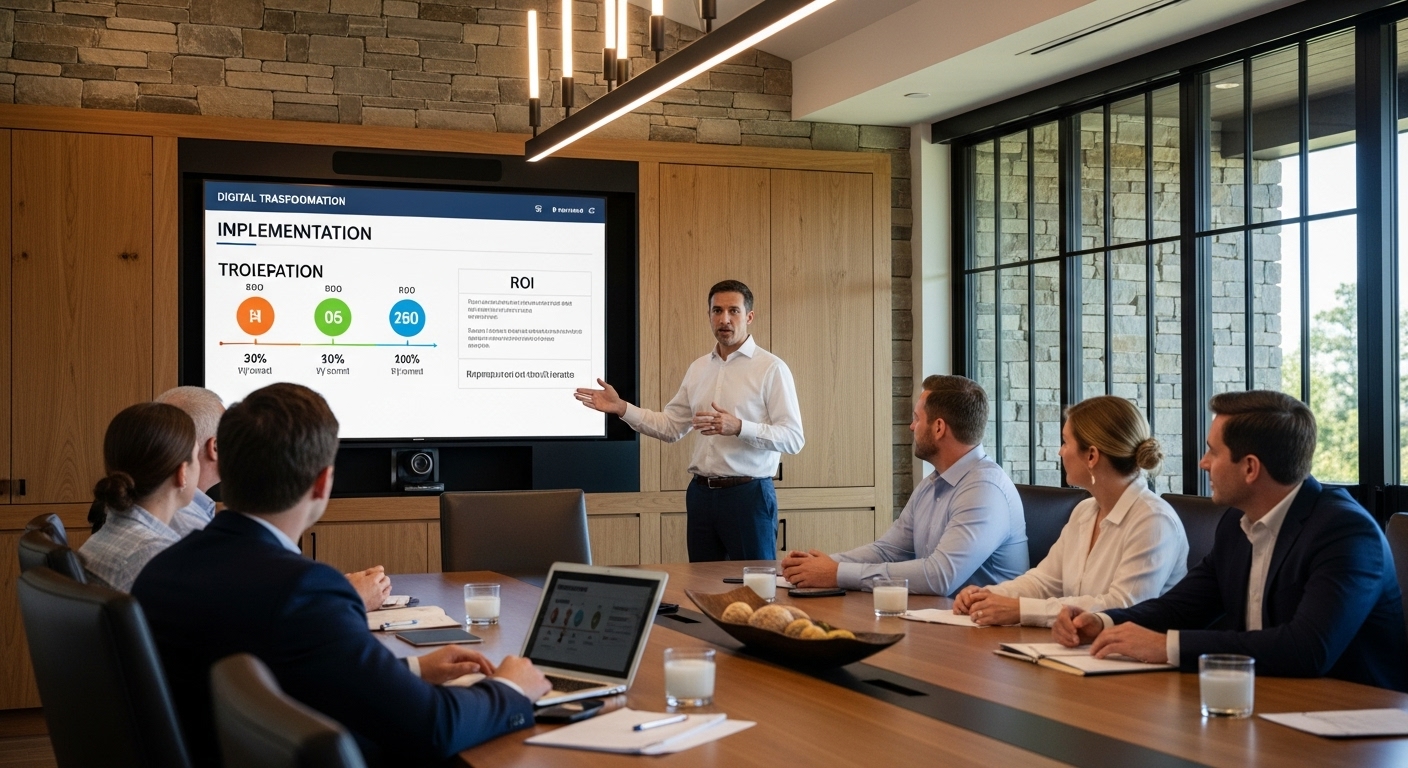August 13, 2025 by 100XBuilds Team
Digital Transformation Roadmap for Mid-Market Builders

When Meridian Custom Homes increased their project delivery speed by 47% and reduced overhead costs by $340,000 annually, they didn't hire more staff or expand their facilities. They simply stopped fighting against the digital tide and embraced a systematic technology transformation that repositioned them as the most efficient luxury builder in their market.
The harsh reality facing mid-market builders today isn't just about competition—it's about survival in an industry where digital-native companies are capturing market share with superior efficiency, transparency, and client experience. While you've been perfecting craftsmanship, your competitors have been perfecting systems.
The Digital Divide: Where Traditional Builders Fall Behind
The construction industry lags 20 years behind other sectors in digital adoption, but luxury home building faces an even steeper challenge. Your clients expect the same seamless digital experience they receive from their wealth managers, luxury retailers, and high-end service providers.

Current pain points plaguing traditional builders:
Project delays averaging 23% beyond scheduled completion: Manual coordination failures between trades, suppliers, and internal teams
Change order disputes consuming 15-20% of project management time: Paper-based approval processes creating communication gaps
Client communication breakdowns leading to 34% of negative reviews: Lack of real-time project visibility and update systems
Administrative overhead eating 18-22% of gross margins: Redundant data entry, manual scheduling, and inefficient resource allocation
Talent acquisition challenges with 67% longer hiring cycles: Younger workforce expects modern tools and digital workflows
The builders thriving in today's market aren't necessarily building better homes—they're building better systems.
Phase 1: Foundation Assessment and Quick Wins (Months 1-3)
Before implementing new technology, you need a clear picture of your current digital maturity. This assessment phase identifies immediate opportunities while building momentum for larger transformations.
Digital Maturity Audit
Communication systems evaluation: Document how information flows between office, field, clients, and vendors
Data management assessment: Identify where project information lives and how it's accessed
Process mapping: Chart every step from lead generation through project completion and warranty
Technology inventory: Catalog existing software, hardware, and digital tools currently in use
Team capability assessment: Evaluate current digital skills and identify training needs

Immediate Impact Implementations
Cloud-based project management platform: Implement systems like Buildertrend or CoConstruct for instant project visibility improvements
Digital document management: Eliminate paper contracts and change orders with DocuSign integration
Client communication portal: Provide real-time project updates, photo sharing, and milestone tracking
Mobile field reporting: Equip superintendents with tablets for instant progress updates and issue documentation
Automated scheduling systems: Replace manual coordination with integrated calendar management
These foundational changes typically generate 15-25% efficiency improvements within 90 days while preparing your organization for more sophisticated implementations.
Phase 2: Core System Integration (Months 4-8)
The second phase focuses on connecting disparate systems and eliminating data silos that create inefficiencies and errors.
Customer Relationship Management (CRM) Implementation
Lead management automation: Capture, score, and nurture prospects through automated workflows
Client lifecycle tracking: Monitor every interaction from initial inquiry through warranty completion
Sales pipeline optimization: Implement systematic follow-up processes and conversion tracking
Referral program automation: Systematize your most valuable lead source with automated referral requests and tracking

Financial Management Integration
Real-time project profitability tracking: Connect project management with accounting for live margin analysis
Automated invoicing and payment processing: Reduce collection time and improve cash flow with systematic billing
Cost tracking and budget management: Monitor actual versus projected costs at granular levels
Vendor payment automation: Streamline subcontractor and supplier payments with approval workflows
Supply Chain Digitization
Vendor portal implementation: Provide suppliers with direct access to project schedules and material requirements
Automated procurement workflows: Trigger purchase orders based on project milestones and inventory levels
Delivery coordination systems: Integrate supplier schedules with project timelines for optimal material flow
Quality control documentation: Digital inspection checklists and photo documentation for all deliveries
Phase 3: Advanced Automation and Analytics (Months 9-12)
The final implementation phase introduces sophisticated automation and predictive analytics that separate industry leaders from followers.
Predictive Project Management
AI-powered scheduling optimization: Machine learning algorithms that adjust timelines based on historical performance data
Risk assessment automation: Early warning systems for potential delays, cost overruns, and quality issues
Resource allocation optimization: Automated crew scheduling and equipment deployment based on project requirements
Weather impact modeling: Automatic schedule adjustments based on weather forecasts and historical delay patterns

Client Experience Automation
Personalized communication sequences: Automated updates tailored to individual client preferences and project phases
Virtual reality design presentations: Immersive client experiences for design selection and change visualization
Smart home integration planning: Systematic approach to incorporating client technology preferences
Automated satisfaction surveys: Timed feedback collection with immediate issue escalation protocols
Performance Analytics and Optimization
Comprehensive KPI dashboards: Real-time visibility into all critical business metrics
Predictive maintenance scheduling: Proactive warranty and service management based on historical data
Market trend analysis: Automated competitive intelligence and pricing optimization
Team performance optimization: Individual and crew productivity tracking with improvement recommendations
Technology Stack Recommendations by Business Size
$5-10M Annual Revenue Builders
Core platform: Buildertrend or CoConstruct for project management foundation
CRM solution: HubSpot or Salesforce Essentials for lead management and client communication
Financial integration: QuickBooks Enterprise with construction-specific modules
Communication tools: Microsoft Teams or Slack for internal coordination
Document management: Box or Dropbox Business for centralized file storage
Estimated implementation cost: $45,000-65,000 annually
Expected ROI: 280-340% within 18 months

$10-25M Annual Revenue Builders
Enterprise project management: Procore or PlanGrid for comprehensive project oversight
Advanced CRM: Salesforce Professional with construction industry customizations
ERP integration: Sage 300 Construction or Foundation Software for complete business management
Business intelligence: Microsoft Power BI or Tableau for advanced analytics
Collaboration platforms: Microsoft 365 or Google Workspace Enterprise
Estimated implementation cost: $85,000-120,000 annually
Expected ROI: 320-420% within 24 months
$25M+ Annual Revenue Builders
Full enterprise suite: Custom integrations connecting all business systems
Advanced analytics: Predictive modeling and AI-powered optimization tools
Custom client portals: Branded digital experiences with advanced functionality
IoT integration: Smart building systems and construction site monitoring
Advanced security: Enterprise-grade cybersecurity and data protection
Estimated implementation cost: $150,000-250,000 annually
Expected ROI: 380-520% within 36 months
Implementation Strategy and Change Management
Building Internal Buy-In
Executive leadership alignment: Secure C-suite commitment with clear ROI projections and competitive positioning
Champion identification: Select early adopters from each department to drive adoption and provide peer support
Training program development: Comprehensive education plans addressing different skill levels and learning styles
Success metric definition: Establish measurable goals and regular progress reviews

Phased Rollout Strategy
Pilot project selection: Choose representative projects for initial implementation and learning
Gradual expansion: Systematically add features and users based on success metrics and feedback
Continuous optimization: Regular system reviews and adjustments based on performance data
Scalability planning: Ensure chosen solutions can grow with business expansion
Risk Mitigation
Data backup and security: Comprehensive protection for all digital assets and client information
Vendor relationship management: Maintain strong partnerships with technology providers for ongoing support
Contingency planning: Backup systems and processes for critical business functions
Compliance management: Ensure all systems meet industry regulations and client requirements
Measuring Digital Transformation Success
Key Performance Indicators
Project delivery metrics: On-time completion rates, budget adherence, and quality scores
Client satisfaction improvements: Net Promoter Scores, referral rates, and repeat business percentages
Operational efficiency gains: Administrative time reduction, communication effectiveness, and error rates
Financial performance: Margin improvements, cash flow optimization, and revenue per employee
Team productivity: Individual and crew efficiency metrics, training completion rates, and retention statistics
Continuous Improvement Framework
Monthly performance reviews: Regular assessment of all digital systems and processes
Quarterly optimization sessions: Systematic identification and implementation of improvements
Annual technology audits: Comprehensive evaluation of entire digital ecosystem
Industry benchmark comparisons: Regular competitive analysis and best practice adoption
The Competitive Advantage of Digital Leadership
Builders who complete comprehensive digital transformation don't just improve efficiency—they fundamentally change their market position. They become the preferred choice for discerning clients who value transparency, communication, and professional sophistication.

Market positioning benefits:
Premium pricing justification: Digital sophistication supports higher margins through demonstrated value
Talent attraction advantage: Modern tools attract top-tier employees and subcontractors
Client retention improvement: Superior experience creates lasting relationships and referral generation
Scalability foundation: Systems-driven operations enable growth without proportional overhead increases
Risk reduction: Better data and processes minimize costly mistakes and delays
The question isn't whether digital transformation is necessary—it's whether you'll lead the change or be forced to follow. The builders implementing comprehensive technology roadmaps today are creating insurmountable competitive advantages that will define market leadership for the next decade.
"We didn't just adopt new software—we transformed how we think about building homes. Our clients now see us as the most professional, responsive, and reliable builder they've ever worked with. That reputation is worth more than any marketing campaign." - Sarah Mitchell, President, Meridian Custom Homes
Your digital transformation journey starts with a single decision: commit to systematic change or accept gradual market share erosion. The technology exists, the roadmap is proven, and your competitors are already moving.
Ready to begin your digital transformation? Contact 100XBuilds today for a comprehensive digital maturity assessment and customized technology roadmap. We'll show you exactly how to implement the systems that will position your company as the market leader in efficiency, client experience, and profitability. Don't let another quarter pass while your competitors gain digital advantages—start building your technology foundation today.
